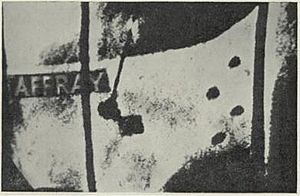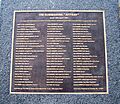HMS Affray (P421) facts for kids
class="infobox " style="float: right; clear: right; width: 315px; border-spacing: 2px; text-align: left; font-size: 90%;"
| colspan="2" style="text-align: center; font-size: 90%; line-height: 1.5em;" | 
|}
HMS Affray was a British Amphion-class submarine. She holds a sad record: she was the last Royal Navy submarine to be lost at sea. This happened on 16 April 1951, and all 75 people on board were lost. All submarines in her class had names starting with 'A'. Affray was the only ship in the Royal Navy named after a "noisy and disorderly fight."
Affray was built near the end of World War II. She was one of 16 submarines in her class. These submarines were originally designed to operate in the Pacific Ocean against Japan.
Contents
- The Last Mission
- The Search for Affray
- Finding the Wreck
- What Caused the Sinking?
- Visiting the Wreck Site
The Submarine's Journey
Building a Modern Submarine
Affray was built at the Cammell Laird shipyard in Birkenhead. Her construction began on 16 January 1944. She was launched into the water on 12 April 1944 and officially joined the navy on 25 November 1945.
At the time, Affray and her sister submarines were very advanced. Their design was the result of quick submarine development during World War II. Some ideas for her design came from captured German U-boats. Her unique features included a way of building her in parts and a hull that was completely welded together.
She was designed for long trips in the Far East. This meant she had special features like refrigeration and two large air conditioners. Her living areas were placed far from the noisy engine room. She also had ten torpedo tubes, making her one of the most powerful submarines of her time.
Global Travels and Training
After being built, Affray joined the 3rd Submarine Flotilla. She then became part of the British Pacific Fleet. For the next four years, Affray traveled and took part in training exercises around the world. She visited many places, including Australia, Singapore, Japan, Morocco, South Africa, Pearl Harbor, and Bergen.
Upgrades and New Features
On 11 March 1949, Affray was moved to a reserve fleet. She went into a drydock to get a new feature called a snort mast. This was a steel tube that could be raised and lowered using air pressure.
When raised, the snort mast acted like a snorkel. It allowed the submarine to take in fresh air and let out engine exhaust while staying underwater at periscope depth. This meant the submarine could charge its batteries and run its diesel engines without having to surface.
The snort mast on Affray was designed for both air intake and exhaust. Later, this design was changed so the snort mast only took in air, and the exhaust was moved. The snort mast also had a special valve that would close automatically if the submarine went too deep.
In December 1949, Affray was sent to the Mediterranean Sea. During deep dives there, it was noted that she started "leaking like a sieve." Her diesel engines also began leaking oil.
In January 1951, Affray was moved to Portsmouth Naval base. In March, she was brought back into active service. Lieutenant John Blackburn, who had won the DSC, became her commanding officer. His job was to get the submarine and its new crew ready for operations.
The Loss of HMS Affray
The Last Mission
On 16 April 1951, Affray began a practice war mission called Exercise Spring Train. She had a smaller crew of 50 people instead of the usual 61. Also on board were four Special Boat Service marines, an engineer commander, a naval instructor, seven engineering lieutenants, and 13 sub-lieutenants. The last two groups were trainees learning to be submarine officers. This brought the total number of people on board to 75.
The captain's orders were flexible. The marines were to be dropped off on an isolated beach in Cornwall during the night. The exercise was planned to last until 23 April, when Affray was due back for repairs, including a leak in a battery tank.
Affray left her home base around 4:00 PM. She made normal contact at 9:00 PM to confirm her position and speed, and said she was getting ready to dive. The last ship to see her on the surface was HMS Contest. When Affray missed her 8:00 AM report the next day, she was declared missing, and a search began immediately.
The Search for Affray
Shore stations tried to call Affray all day. HMS Agincourt led a search fleet that grew to 24 ships from four different countries. Other submarines, like HMS Scorcher, also joined the search. They flew large white flags so they wouldn't be mistaken for the missing Affray.
The special code word 'SUBMISS' was sent to all NATO navy ships. All other Amphion-class submarines were ordered to stay in port while the navy investigated. The disappearance of Affray was huge news in Britain, even pushing other important events off the front page of newspapers.
There was a great urgency in the first 48 hours of the search. It was thought the crew might not survive much longer if they were still alive. During the search, some ships thought they heard a Morse code signal by tapping on a submarine hull, saying "We are trapped on the bottom." However, later investigations suggested these sounds came from other search ships.
After three days, the search slowed down. Fewer ships were used to find Affray. Many strange things happened during the search. One search vessel found a massive object on the seabed that was too big to be Affray. When it returned days later, the object was gone. Another strange story was that the wife of a captain of a sister submarine claimed a ghost in a wet uniform told her the correct location of the sunken sub.
Because the English Channel had so many shipwrecks (161 were found, mostly from World War II), it took almost two months to find Affray.
Finding the Wreck
On 14 June, the main search ship HMS Loch Insh found something with its sonar. It was on the edge of Hurds Deep, a deep underwater valley in the English Channel. This was the same area where an oil slick had been seen when Affray disappeared.
HMS Reclaim arrived hours later. A diver went down and reported seeing a long white handrail. The weather was bad, so the crew used an underwater camera. The very first thing the camera showed were the letters "YARFFA"—Affray spelled backward!
Finally, she was found. She lay about 17 miles (27 km) northwest of Alderney, closer to France than England. She was in 86 meters (about 282 feet) of water, tilted slightly to her left side. Over the next few months, she slid further, resting at about a 50-degree angle.
Divers found no signs of a collision or damage to her hull or bridge. The search periscope and radar mast were extended, meaning she was at periscope depth when she sank. However, the snort mast was broken and lay next to the submarine, held by only a thin piece of metal. All hatches and torpedo doors were shut. The two emergency buoys were still inside, though one could not have been released because its wooden cover was wired shut. It was clear no one had tried to escape. The only clue was that the bow hydroplanes (fins that control depth) were set to rise, and the bridge controls were in the "stop" position. The snort mast was the only part of the submarine recovered, and it was later found to be poorly made. This might have helped cause the sinking.
What Caused the Sinking?
Many ideas have been suggested about why the submarine sank. Since the snort mast was broken, it was first thought that it broke and flooded the submarine. But after looking closely at the snort mast, it seemed more likely it broke when the submarine hit the bottom. Even though the snort mast was found to be faulty, tests showed it should have worked normally.
A battery explosion has also been suggested. The Royal Navy tried to scan the inside of Affray using a special device when she was first found. This didn't give much information, but it seemed to show that the internal valve for the snort mast was open. This would mean at least one part of the submarine flooded, and some crew members drowned when she hit the bottom. The Admiralty decided against more attempts to find out why Affray sank because it was too dangerous for divers.
A more recent idea is that the snort mast went below the surface, and its float valve failed. If this happened, up to 13 tons of water per minute could have poured into the submarine. This would have made her sink very quickly. With fewer crew members and trainees possibly getting in the way, it would have taken longer to stop the water. By the time the valve was shut, or the flooded area sealed off, there might have been too much water for the submarine to surface, even by blowing out all her ballast. If the control room flooded, no one would have been alive to blow the ballast. It's also possible that with trainees operating systems, a problem with the clutch made Affray speed up and hit the seabed, damaging parts that would help her rise.
Visiting the Wreck Site
Almost 50 years after the loss, Innes McCartney, a diver who loves sunken submarines, got the exact location of Affray from the Ministry of Defence. He dived to the sunken submarine and shared what he saw:
"As we went down, a large dark shape appeared. Not much light reaches 83 meters deep. Soon, we saw the clear shape of a submarine. She looks very impressive, sitting almost completely off the seabed. Our lights showed she is now covered with sponges and anemones, adding color in the darkness.
The first thing I noticed was her huge size. She is one of the largest submarine wrecks in the Channel. She lies slightly on her left side, with her front pointing northeast. She doesn't have many fishing nets caught on her, just a few craypots.
The wreck is in very good condition, considering she has been on the seabed for 47 years. Her bridge is completely whole, with speaking tubes and radio antennas still there. Her navigation lights are on the side of the conning tower, and the ladder is still in place. Her periscope shafts stand straight up, and even the cables between them are still there.
Forward of the tower, the front deck is intact. I found the cradle where the snort mast was located. The base of the snort mast was still there, showing where it broke off. Later, at the Royal Navy Submarine Museum, I saw the part of the mast that was recovered. They would still fit together perfectly. The front and back hydroplanes are still in place, and the external torpedo tubes on the bow look very impressive.
Behind the conning tower, there are signs of the Royal Navy's attempts to salvage her in 1951. Our diving team found no other damage to the wreck apart from the missing snort mast. This matches what the Royal Navy found. She is an important and sad reminder of our naval history. Very few divers can do such a deep dive. This should help keep Affray undisturbed for the future. She is a war grave, the final resting place of 75 naval people, and this should be respected."
As of 2001, under the Protection of Military Remains Act 1986, Affray was made a controlled site. This means it is illegal to dive to her without a special permit from the Ministry of Defence.
Images for kids




